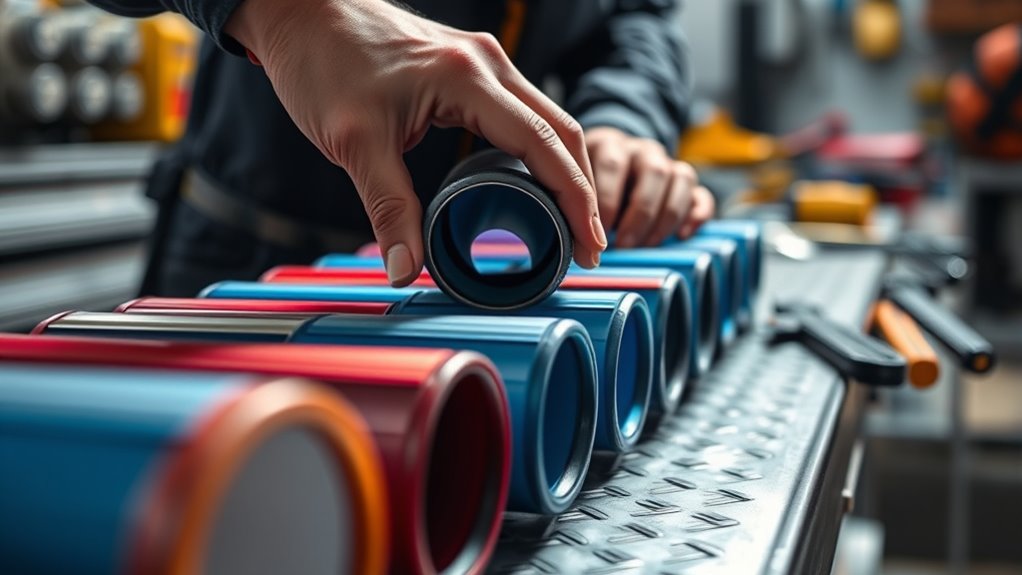To choose the right respirator filters for finishing, you need to match the filter type to the specific particles, fumes, or vapors you’ll encounter. Check your respirator’s manufacturer guidelines to ensure compatibility and proper fit, which is essential for safety. Inspect filters regularly, replace them when dirty or clogged, and dispose of used filters correctly. To stay protected, understanding these steps is critical—continue exploring for detailed tips to maximize your safety and effectiveness.
Key Takeaways
- Match filters specifically designed for your respirator model to ensure proper fit and protection.
- Check manufacturer labels for filter type compatibility with finishing tasks such as fumes or dust.
- Inspect filters regularly for damage or clogging; replace immediately if compromised or after recommended usage.
- Use appropriate filters (e.g., particulate, chemical) based on the hazards present during finishing work.
- Handle filters with gloves, avoid touching filter surfaces, and dispose of used filters according to safety regulations.

Are you aware of how vital respirator filters are when finishing a project? They serve as your frontline defense against harmful particles, fumes, and vapors that can compromise your health. Choosing the right filter isn’t just about picking the most popular brand; it’s about understanding filter compatibility. Not all filters fit every respirator, so you need to verify that the filter you select matches your specific model. Check the manufacturer’s specifications and labelings carefully—using incompatible filters can reduce effectiveness and even pose safety risks. Proper compatibility guarantees a secure fit, preventing unfiltered air from bypassing the filter and reaching your lungs.
Ensure filter compatibility for safe, effective respirator protection during your project.
Once you’ve selected the correct filters, maintaining them properly becomes equally important. Regular maintenance tips include inspecting filters before every use for signs of damage or clogging. If a filter appears dirty or clogged, replace it immediately—don’t wait for it to fail completely. Keep spare filters on hand so you can swap them out quickly without interrupting your workflow. Also, store spare filters in a dry, cool place to prevent deterioration over time. When installing new filters, follow the manufacturer’s instructions to verify a tight, secure fit. Loose filters can compromise the seal, allowing contaminated air to bypass the filter altogether.
It’s vital to understand that filters don’t last forever. Their lifespan depends on the type of work, exposure level, and environmental conditions. Many filters have a recommended usage time—check the packaging or manufacturer’s guidelines regularly. Even if a filter looks clean, it might have lost its effectiveness, especially if it’s been used in high-contamination environments. Using expired or overused filters can give you a false sense of security, so adhere to the recommended replacement schedule to verify optimal protection.
Another essential maintenance tip is to avoid touching the filter surface with your fingers, which can transfer oils or dirt that reduce the filter’s efficiency. When handling filters, use gloves if possible, and always handle them by the edges. After finishing a project, dispose of used filters properly, following local hazardous waste disposal regulations. Proper disposal prevents potential contamination and keeps your workspace safe.
Frequently Asked Questions
How Often Should Respirator Filters Be Replaced During Finishing Projects?
For your finishing projects, you should follow a proper filter replacement schedule to guarantee safety. Typically, replace filters when they become visibly dirty, clogged, or if you notice breathing resistance increases. Regular maintenance tips include inspecting filters daily and replacing them as needed, especially after exposure to dust or fumes. Always adhere to manufacturer guidelines to maintain maximum protection, and don’t delay replacing filters to keep your respiratory system safe.
Can I Use the Same Filter for Paint Fumes and Dust?
You shouldn’t use the same filter for paint fumes and dust because filter compatibility varies. Paint fumes require cartridges with chemical resistance to effectively filter out volatile organic compounds, while dust filters are designed for particulate matter. Using incompatible filters can reduce protection and pose health risks. Always choose filters specifically rated for the substances you’re working with, ensuring proper chemical resistance and compatibility for safe, effective respiratory protection.
Are Reusable Respirator Filters More Cost-Effective Long-Term?
Think of reusable respirator filters as the wise investment that pays off over time. They’re often more cost-effective long-term because, with proper care, you can use them repeatedly, reducing ongoing expenses. When you do a thorough cost analysis, you’ll see savings grow, and you’ll also lessen your environmental impact by generating less waste. So, choosing reusable filters can be a smart move for your budget and the planet.
How Do I Properly Dispose of Used Respirator Filters?
When it’s time to dispose of used respirator filters, you should follow proper filter disposal procedures to minimize environmental impact. Check your local regulations for disposal options, as some filters may need to be treated as hazardous waste. Avoid throwing them in regular trash, and consider recycling programs if available. Proper filter disposal helps reduce environmental harm and keeps your workplace safe and compliant with health standards.
What Are the Signs That a Filter Is No Longer Effective?
Ever wonder if your filter’s still doing its job? You’ll notice signs like increased breathing resistance, unpleasant odors, or visible contamination—these indicate your filter’s no longer effective. Keep an eye on the filter lifespan and replace filters promptly to prevent filter contamination. Ignoring these signs can compromise your safety, so trust your senses and follow manufacturer guidelines to guarantee your respirator provides maximum protection at all times.
Conclusion
Remember, safety isn’t just an option—it’s a priority. Choosing the right respirator filters protects you from harmful fumes and dust during finishing projects. Take the time to select filters that match your tasks, and don’t cut corners. As the saying goes, “An ounce of prevention is worth a pound of cure.” Stay vigilant, stay safe, and finish your projects with peace of mind knowing you’re well-protected every step of the way.









